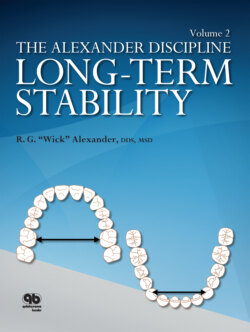The 20 Principles of the Alexander Discipline, Volume 2

Реклама. ООО «ЛитРес», ИНН: 7719571260.
Оглавление
R.G. "Wick" Alexander. The 20 Principles of the Alexander Discipline, Volume 2
Table of Contents
Dedication
Preface
Overview
Examination and diagnosis
Treatment timing
Treatment plan
Discussion
Evaluation
Final analysis
Summary
Acknowledgments
Author’s Note
CHAPTER 1. Introduction: Begin with Stability in Mind
The Room of Truth
Six Guidelines to Building Facial Harmony and Stability
Conclusions
References
Case 1-1
Case 1-2
CHAPTER 2. Selective Literature Review on Long-Term Stability
History of Treating Malocclusion
Relapse
Diagnosis and Treatment Planning
Cephalometric Guides
Mandibular First Molar Position
Angulation (Artistic Positioning) of Mandibular Incisors
Active Treatment
Alexander Discipline Technique
Unique bracket selection and prescription
Unique arch form
Treatment mechanics
Long-term research studies
Summary
Acknowledgments
References
Case 2-1
Case 2-2
Case 2-3
CHAPTER 3. Special Considerations in Orthodontics
Periodontal Considerations
Potential periodontal problems during orthodontic treatment
Orthodontic correction of periodontal problems
Posttreatment care
Temporomandibular Joint Considerations
Pretreatment considerations
Diagnosis
Treatment planning
Splint therapy
Occlusal equilibration
Surgery
Orthodontic treatment
Balance
Acknowledgments
Case 3-1
Case 3-2
CHAPTER 4. Anterior Torque Control
Incisor Mandibular Plane Angle Position
Evidence
Mechanics
Exceptions
Nasolabial Angle
Evidence
Mechanics
Exceptions
Interincisal Angle
Evidence
Mechanics
Exceptions
Summary
References
Case 4-1
Case 4-2
Case 4-3
CHAPTER 5. Sagittal Skeletal Alteration and Vertical Skeletal Control
Growth
Sagittal Skeletal Control
Maxilla
Mandible
Evidence
Mechanics
Exceptions
Vertical Skeletal Control
Vertical Class II skeletal correction
Vertical Class III skeletal correction
Summary
References
Case 5-1
Case 5-2
CHAPTER 6. Transverse Skeletal Alteration
Mandibular Intercanine Width (3 × 3)
Evidence
Mechanics
Exceptions
Maxillary Intermolar Width
Evidence
Mechanics
Exceptions
Maxillary and Mandibular Arch Forms
Evidence
Mechanics
Exceptions
Discussion
Alexander arch form
References
Case 6-1
Case 6-2
CHAPTER 7. Functional Occlusion and Stability
Functional Occlusion
Mechanics
Soft tissue profile
Long-Term Stability Goals
Root positioning
Leveling the mandibular arch in deep bite treatment
References
Case 7-1
Discussion
Case 7-2
Case 7-3
Case 7-4
CHAPTER 8. The Smile and Facial Harmony
Facial and Dental Midlines
Tooth Size
Tooth Angulation
Cant of the Occlusal Plane
Smile Line
Vertical maxillary excess with excessive gingival exposure (nongrowing patients)
VME with inadequate gingival exposure (nongrowing patients)
VME with inadequate gingival exposure (growing patients)
VME with excessive gingival exposure (growing patients with full dentition)
Average skeletal pattern with excessive gingival exposure (growing patients)
Gingival Line
Buccal Corridors
Smile Arc
Finishing
Tooth Color
Conclusion
References
Case 8-1
Case 8-2
Treatment plan
Case 8-3
Case 8-4
CHAPTER 9. Factors Related to Relapse
Possible Sources of Relapse
Third molars
Dental memory
Mandibular intercanine width expansion
Mandibular intermolar width expansion
Reducing overjet and overbite
Interincisal angle
Irregularity index
Mandibular incisor position
Skeletal Stability
Mandible
Maxilla
Class II relapse
Muscular Suspects
Open bite
Myofunctional Therapy for Open Bite
Forces at work
Mouth breathing
Tongue thrust
Occlusal forces
Role of bracket system, archwires, and elastics
Neutral Zone
Bad habits
Retention
References
Case 9-1
Case 9-2. Overview
Case 9-3
Index
A
B
C
D
E
F
G
H
I
L
M
N
P
R
S
T
V
W
Отрывок из книги
Title Page Copyright Page Dedication Preface Acknowledgments Author’s Note CHAPTER 1 - Introduction: Begin with Stability in Mind CHAPTER 2 - Selective Literature Review on Long-Term Stability CHAPTER 3 - Special Considerations in Orthodontics CHAPTER 4 - Anterior Torque Control CHAPTER 5 - Sagittal Skeletal Alteration and Vertical Skeletal Control CHAPTER 6 - Transverse Skeletal Alteration CHAPTER 7 - Functional Occlusion and Stability CHAPTER 8 - The Smile and Facial Harmony CHAPTER 9 - Factors Related to Relapse Index
I clearly remember Dr Tweed’s words of advice, given to us University of Texas orthodontic graduate students in 1963: “If you start and finish one case a week, you will have a successful practice.” In other words, he was telling us that we could not control the treatment and produce quality results with a larger practice. He was recommending that each practitioner have around 100 active patients.
.....
Case 1-1
Figs 1-2a to 1-2c Pretreatment facial views of a 39-year-old woman. (a) Soft tissue profile shows balance. (b) Frontal view shows balance. (c) Smile shows slight asymmetry.
.....